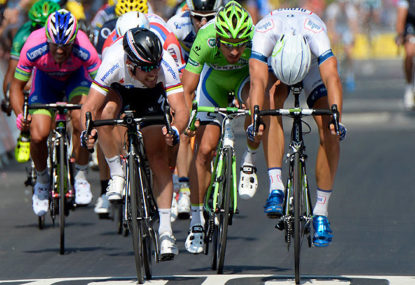'I've just won a stage of the Tour de France, mate!': Hindley grabs yellow jersey as Aussie blows Tour apart
Australia's Jai Hindley has said he is "lost for words" after a shock stage victory at the Tour de France earned him the leader's…

When we see a bunch sprint, it’s easy to assume the rider at the finish has just sprinted faster than anybody else to win.
Maybe they got lucky and avoided a crash, maybe their final lead-out was stellar – maybe it’s time for an article on history’s best lead-out men.
Or maybe, like Robbie McEwan, it was the cunning to remain unseen until 150 metres to go.
There is just so much more to it though, so let’s go through it. The following is a list of things that happen in a bunch sprint you probably won’t notice from your couch.
Being aware of any obstacles ahead of you
This is tricky when high heart-rates don’t even permit clear vision, let alone the motivation to look up from the rear wheel in front of you.
Elbows to the ribs
These are frequent when elevated agitation levels – from prolonged high heart-rates and depleted blood-sugar levels – promote peloton aggression.
Verbal abuse
Profanities aren’t infrequent, let’s put it that way. In fact, threats to one’s family and personal well-being are the only words that will be heard within the wind tunnel of a sprint-chasing peloton.
The age-old quote ‘what happens on the bike stays on the bike’ has its roots in these occurrences. Everyone knows though, that if you get elbowed in the ribs and referred to as a sick-and-ghastly-attempt-at-a-man, it will be remembered after the race.
The ‘washing machine’ effect
When the speed is hot, the only path to the front of the bunch is via the periphery of the bunch, or ‘in the wind’, where the rider is not able to draft behind somebody. That means there is a constant flow of riders coming up the outside of the bunch, and relegating, by default, the riders who were at the front to latter positions.
The riders who are pushed back must therefore go around (also in the wind) to reclaim their positions. Hence, the washing machine effect takes hold.
Riders who haven’t got their teams on the front of the bunch and pacing the group will find themselves in the bulb of riders behind that team, fighting to be first in its draft.
So, as we might see Giant-Shimano driving the bunch, any rider behind Marcel Kittel – or whomever is last in their line, as often they will put a sacrificial lamb behind the leader as a buffer against crashes from the back – is contending with all others for a safe and energy-efficient position.
The further ahead in the bunch a rider is, the less risk of someone crashing in front of them.
The ‘elastic band’ effect
This is the compounded effect of inefficient braking into corners and accelerating out of them to catch the riders in front of you. As each rider leaves a safe gap when braking into a corner, they must then accelerate out of the corner not only as fast as the riders at the front, but also to fill each gap that was left (into the corner) by every rider in front of them.
30 riders leaving 50 centimetres each, totals 15 metres of excess acceleration needed to make back up from 30th wheel. If there are 200 corners in a race, that’s three kilometres extra distance travelled! That is only 30th wheel, not 130th, and it’s all accelerating!
This calculation relates closely to my description of what makes a Roubaix winner.
Remaining at the front of the peloton is highly beneficial, and if a team is strong enough to keep pacing and allowing their leader to remain behind and hassle-free, Lance Armstrong style, the leader will reap those profits at the finish.
Winning a bunch sprint is hard, and much activity happens within this mass of conviction, but at the end of the day having a strong team and being fit enough to remain at the front gives the rider a great deal of help.